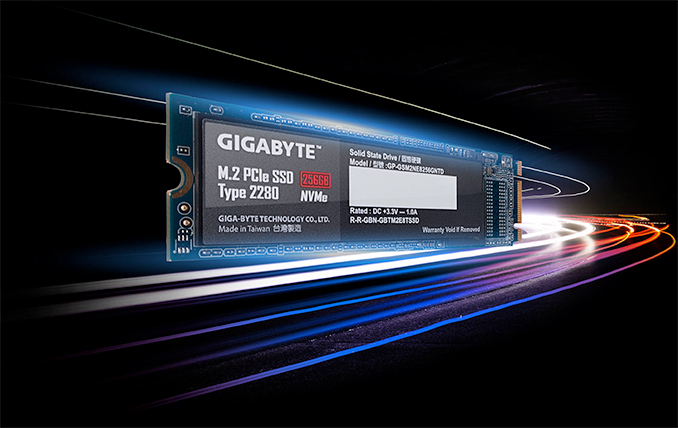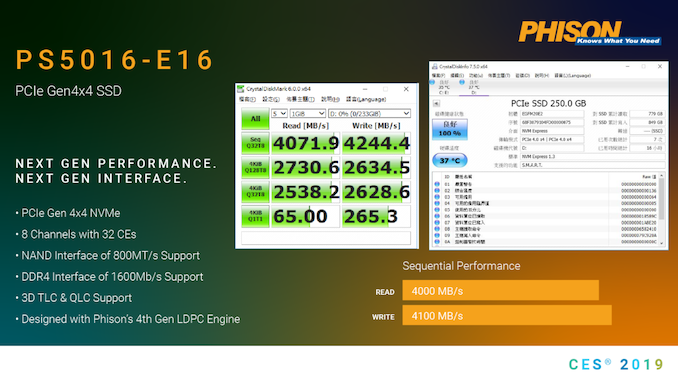GIGABYTE Teases PCIe 4.0 M.2 SSD in Press Release: 5 GB/s
by Anton Shilov on May 24, 2019 9:10 PM EST
A press release sent out by GIGABYTE on Friday said that the company would demonstrate one of the industry’s first SSDs featuring a PCIe 4.0 interface at Computex next week. The company says that its drive will offer maximum sequential read/write speeds of up to 5 GB/s. when used with AMD’s upcoming Ryzen 3000-series platform supporting PCIe 4.0.
GIGABYTE is a rather new player on the SSD market and at present the company only offers drives based on controllers from Phison. Therefore, it is more than likely that GIGABYTE will showcase a PCIe 4.0 x4 SSD based on Phison’s PS5016-E16 controller that the chip developer demonstrated earlier this year at CES 2019. Keep in mind though that GIGABYTE has not officially confirmed use of the Phison controller.
The Phison PS5016-E16 processor has 8 NAND channels with 32 CE targets that supports interface speeds of up to 800 MT/s. Featuring Phison’s 4th Gen LDPC ECC engine, the controller can support both 3D TLC and 3D QLC NAND flash memory. To ensure high performance, it can also support a DDR4-1600 DRAM buffer.
One interesting thing to note about the SSD that GIGABYTE plans to demonstrate is that it was published as that it will offer up to 5 GB/s read/write speeds ‘in low temperatures’, which suggests that this drive will require a sophisticated cooling to show all of its advantages. It is also noteworthy that 5 GB/s speeds will likely be hit by high-capacity drives only given 8 NAND channels at 800 MT/s featured by the controller.
It is noteworthy that back in January a prototype SSD powered by the PS5016-E16 could only offer 4/4.2 GB/s read/write speeds. Given GIGABYTE’s performance figures, it is evident that Phison has managed to significantly boost performance of SSDs based on its controller in less than half of a year.
Computex 2019 trade show will take place in Taipei, Taiwan, from May 28 to June 1, 2019.
Related Reading:
- The GIGABYTE Aorus RGB M.2 SSD Review: Nothing Is Too Small For RGB LEDs
- Patriot Launches Viper VPN100 SSDs: Up to 2TB, Massive Heatsink
- OSS Unveils 5-Way PCIe 4.0 Backplane, Demonstrates PCIe 4.0 HPC Platform
- Microsemi Announces PCIe 4.0 Switches And NVMe SSD Controller
Source: GIGABYTE
| Want to keep up to date with all of our Computex 2019 Coverage? | ||||||
 Laptops |
 Hardware |
 Chips |
||||
| Follow AnandTech's breaking news here! | ||||||











42 Comments
View All Comments
eek2121 - Saturday, May 25, 2019 - link
it's going to be a long time before PCIE 5.0 devices are on the market (devices meaning motherboards and add-in cards). PCIE 4.0 was ratified on June 8, 2017. We are just now beginning to see a trickle of products 2 years later. It takes time to develop new products. PCIE 5.0 was just ratified this year. That means that 2022 or 2023 we'll see CPUs and products take advantage of it. We MIGHT see something in 2021, but not before then.Irata - Saturday, May 25, 2019 - link
Yes, it's really interesting - both Fudzilla and Anandtech did not mention Zombieload even once - afaik not even in the tweets. This is a bit strange since this was important tech news and pretty much every other site reported on it.Even the fact that Google disabled HT for Intel based Chrome books was not mentioned here, or how Apple said that in order to be fully protected you will need to disable HT in addition to the patches.
Phynaz - Sunday, May 26, 2019 - link
AMD is irrelevant. Get used to itAlexvrb - Saturday, May 25, 2019 - link
To be fair the May update implements Retpoline and fast import, which will help users regain much of their lost performance. How much will vary, and I'd love to see some tests. With that being said I'm really looking forward to seeing Zen 2 chips hit the market. The only really interesting news coming out of Intel recently is rumors about their discrete graphics.xstylus - Saturday, May 25, 2019 - link
Great. Wonderful. Lovely. When can I have 4TB in a M.2-2280 form factor, please?Billy Tallis - Saturday, May 25, 2019 - link
The consumer market isn't ready for that yet. Prices still need to come down a lot. Going to 4TB on a M.2 SSD is possible with current chips, but it generally requires moving from DDR3 to DDR4 DRAM and from 256Gb to 512Gb NAND in order to fit everything on the card. That means a 4TB drive is pretty different from lower capacity versions, and isn't something that can easily or cheaply be added to existing product lines.damianrobertjones - Monday, May 27, 2019 - link
They're waiting for sales to drop on the other drives and then, as we know, they'll drop the new items. It nothing to with the market being ready... it's to do with making the most £££/$$$.boeush - Saturday, May 25, 2019 - link
What's noteworthy, yet is rarely if ever mentioned, is that these numbers are at QD32. Meaning, any normal/typical user won't ever see even half this type of performance. I wish the focus went to QD1 numbers as a priority, with QD>1 provided only as a secondary reference, or an afterthought. Maybe in a format something like this:"read/write speeds 0.065(<5)/0.265(<5) GB/s"
cmdrdredd - Saturday, May 25, 2019 - link
Yeah I don't see many doing anything to get close to the potential.jabber - Sunday, May 26, 2019 - link
To be honest NVMe x4 was a big let down. I'd settle for cheap reliable drives that just pushed 1000MBps R/W with lower latency.